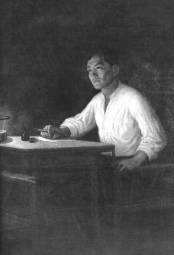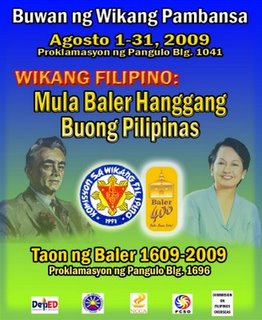August is the Philippines’ Buwan ng Wika (Language Month, formerly known as the week-long Linggo ng Wika), but which among the more than 170 languages should we really consider as our mother tongue? What is really our wikang pambansâ?
These questions have been wading like a lost fish within the convoluted sea of thoughts of concerned linguists and scholars for almost a century now. But regardless of legal pronouncements and declarations, the matter over our national language hasn’t been officially resolved yet. And with the series of unfortunate events that have been pounding us like ferocious typhoons all these years, it might even be impossible for our generation to witness our country to finally obtain an undisputed national language.
The controversial 1987 Constitution unclearly states that “the national language of the Philippines is Filipino.” However, in a historical sense, the term Filipino pertains not to a language but to a group of Spaniards who were born in the Philippines at the height of Spanish rule (they were introduced to us in our elementary school days as insulares). In a nationalistic sense, and as politically defined, the term Filipino means the native inhabitants of the Republic of the Philippines. Thus, this vague statement that Filipino is the national language is just that — simply vague. And the authors of this confusing constitutional passage chose Tagalog as the basis of our national language. Anyway, from Aparri to Joló, it’s unthinkable nowadays to encounter someone who doesn’t know how to speak or understand it. Mass media, which utilizes Tagalog exclusively, is the main disseminator of the language. Thus, is it safe to assume that the constitution is right after all, that we should all concede to Tagalog as the nation’s lingua franca?
But that’s beside the point of all this.
A la tagale
The Komisyon sa Wikang Filipino (KWF) recently declared that this month’s theme is Mula Baler Hanggang Buong Pilipinas, implying that Tagalog is indeed the national language, with Baler being the birthplace of the Father of the National Language, Manuel L. Quezon (who ironically thought, wrote, and spoke more in Spanish).
But just a few years ago, the KWF celebrated this theme — Ang Buwan ng Wikang Pambansa ay Buwan ng mga Wika sa Pilipinas — the language month is the month of all Philippine languages. With this theme, it seems that the Komisyon is putting more confusion into the minds of Filipinos, especially the studentry. Are they now telling us that all Philippine languages are considered and accepted as the national language in lieu of Tagalog? If they were just speaking metaphorically, then the simple, impoverished, and half-starved Pinoy pitifully missed their point. Fortunately, the Filipino studentry do not seem to care about the Komisyon’s confusing theme; they’re more concerned over Lady Gaga, The Pussycat Dolls, Korean soaps, personalized shirts, fruit-flavored condoms, and the like.
But at the rate this language crisis is going, I think I’d rather have the Filipino youth’s eyes be ensconced in Scarlett Johansson’s cleavage and Hugh Jackman’s six-pack.
Pinoy tower of babel
The Philippines is an archipelagic Babylon, a maelström of tongues. This issue over our country’s national language has been an ageless controversy that has not been given much limelight in national issues and public fora. Anyway, the Philippines has so much laundry to do, so why should it bother with a “harmless” little critter in the form of a pesky language turmoil?
For one: language is a national and social phenomenon. It’s more important than one’s daily Kapamilya or Kapuso schedule.
A long time ago, a mighty language from the West (ever since the advent of our neocolonized patrimony, Spanish has been maligned and taught to us by a neocolonial education as nothing but a foreign atrocity) united the more than a hundred tongues (and united the more than a thousand islands, as well as hundreds of tribal kingdoms) in the Philippines which resulted in the country’s short-lived independence in 1898 (sorrowfully, since the American invasion, we were never able to look back to that glorious and legendary self-governance with impartiality and kindness). But this 1898 event served as the impetus for a very few well-intentioned politicians of the Commonwealth of the Philippines to continuously disturb the US colonizers for our country’s complete freedom (which up to now seems to be futile).
During the Commonwealth wherein Manuel L. Quezon was then president, the creation of a national language was naturally inevitable. On 31 December 1937, Tagalog was chosen as the country’s national language (this became the basis as to why the current constitution still uses Tagalog for our national language), eventually earning Quezon the title Ama ng Wikang Pambansa (Father of the National Language).
This is when the controversy actually began. And it worsened when, in 1959, Tagalog was renamed Pilipino. But it reverted back to Tagalog under the 1973 Constitution.
It’s not only the terminology that’s in question here but the orthography of the language as well. It is well known that Tagalog, including all the rest of the native languages, used an ancient alphabet (from a vague Arab influence) called alíbata (some say that it should be called baybayin). Propagandistas and literate indios used this alphabet, as well.
During the US occupation, the Americans were able to murder, bit by bit, almost all traces of our Spanish heritage. One of the victims was the abecedario, already part and parcel of the Filipino soul for more than three decades. The change of alphabet took ominous form when, in 1937, the Commonwealth created the National Language Institute which made a study and survey on which national language should be used. Tagalog won amidst the chagrin of other natives who spoke other languages. But US desecration of our country’s language never stopped there.
The Santos Debacle
On 18 June 1938, the Commonwealth’s National Assembly created the Institute of National Language (not to be confused with the National Language Institute). This new language body was tasked to prepare a dictionary and grammar. Thus was born the erroneous, faulty, and clumsy Balarila ng Wikang Pambansa authored by none other than the great Filipino lexicon and writer, Lope K. Santos. He was the J.R.R. Tolkien of his time in terms of inventing words. But Santos’ work was of no great help in the development of a national language. It only made things worse. It virtually murdered the Filipino alphabet, killing many Filipino words in the process.
And I suspect that he knew that.
Santos was a journalist who was entangled in the celebrated libel case of the newspaper he was working with during the early 1900s. On 30 October 1908, his newspaper El Renacimiento (The Rebirth) published an editorial entitled Aves de Rapiña (Birds of Prey). It was a “blind item” meant for then Secretary of the Interior Dean C. Worcester, but the American diplomat immediately felt that he was the one being alluded to by the attacks mentioned in the editorial, e.g., that he was economically exploiting certain parts of the Philippines (particularly Benguet and Mindanáo). He filed a lawsuit against the newspaper’s owner and men, which included Santos. The trial lasted for several years. Worcester won the case.
During the course of the trial, it wasn’t impossible that Santos may have been under duress from a Worcester payback…
The composition of the Balarila must have began during those years. Most probably, during the younger years of the 1900s, the US government in the Philippines, under the auspices of Worcester, have been plotting all along on how to destroy the foundation of our language: the abecedario. It should be noted that even during the final years of Spanish rule, Worcester was already in the Philippines. So I won’t be surprised if, in a future historical discovery, he was acting as a spy for the US. Therefore, plotting out the destruction of our language must have begun several years before the Commonwealth.
Now, many scholars say that the decision to choose Tagalog over other languages in the country is that the said language is the language of the nation’s capital, Manila. Furthermore, alongside Spanish, it was the language of the 1896 Revolution and the violent Katipunan. And again, the center of action during the Revolution was in Tagalog Manila. Another reason is that Tagalog has a vast treasure trove of literary works. Tagalog has published more books compared to other native languages. But for all we know, another factor could be president Quezon’s Tagalog origin.
But if we are to look closely into this matter, then one would find out that something fishy is going on.
It’s not easy to convince the Filipinos to accept Tagalog as the national language since we have several languages to consider. So the plotters have found a very reliable weapon in the persona of National Hero José Rizal.
A Dubious Poem
Pepe Rizal was already a legend, an icon even before the Commonwealth. And what better way to convince the Filipinos to accept Tagalog as the mother tongue by using a poem that was allegedly authored by him: the dubious Sa Aking Mga Kabata (To My Fellow Youth).
Take into account this passage from the said poem (with an English translation).
Ang hindi magmahal sa kanyang salita
Mahigit sa hayop at malansang isda,
Kaya ang marapat pagyamaning kusa
Na tulad sa inang tunay na nagpala.
One who doesn’t love his native tongue,
Is worse than putrid fish and beast;
And like a truly precious thing
It therefore deserves to be cherished.
Nobody at that time would had ever wanted to go against the ghost of Rizal. Unlike now (what with iconoclast historians such as Ambeth Ocampo and Pío Andrade, Jr. challenging already established historical knowledge), he was almost considered a god. Everything he said in his writings can transform doubtful things into golden truth. So, why not follow his advice? Since he “postulated” that you’re but a stinkin’ blowfish if you don’t love your language, which is the language he “used” in writing Sa Aking Mga Kabata, why not believe in “his wisdom”?
But this is all hogwash. Our “educators” are very proud to say that Pepe Rizal wrote this poem at a very young age of eight.
I say, they’re high on crack.
JOSÉ RIZAL NEVER WROTE SA AKING MGA KABATA! It’s a brazen lie! Even popular historian Ambeth Ocampo himself doesn’t believe that this was written by Rizal.
To prove my point, let us again take a closer look, this time by examining two curious lines from this doubtful verse:
THE Tagalog language’s akin to Latin,
To English, Spanish, angelical tongue
The Tagalog original goes this way:
Ang wikang Tagalog tulad din sa Latin
Sa Ingles, Kastila at salitang anghel

No Meralco, no problemo.
Boys and girls, if you still remember your school days, this poem was allegedly written by Rizal when he was only eight years old. However, at that age, he wasn’t studying Latin yet (his Latin lessons began in 1872 at the Ateneo Municipal de Manila; he was then 11) Although it is known that his Spanish is superb compared to his Tagalog, he wasn’t that confident with the Castilian language during his younger years (remember the “un poco, señor” incident he had with maestro Justiniano Cruz during his early studies in Biñán, Laguna?) since he was just a freakin’ kid. And most of all, English was almost unknown in the country (or at least in Calambâ where he grew up) at that time. When he was eight years old, Rizal never knew the difference between the English language from the Spanish word puta. He never engaged in Tagalog literature. He did attempt to write a novel in Tagalog during his later years (Makamisa), but he wasn’t even able to finish it due to his poor mastery of the language. When Rizal wrote personal letters to his family members and friends, he wrote mostly in Spanish, not Tagalog. His diary was written in the language of Miguel de Cervantes. And most of all, AN EIGHT YEAR OLD DOESN’T HAVE THE INTELLECTUAL CAPACITY YET TO MAKE A CRITICAL ANALYSIS ON COMPARING VARIOUS LANGUAGES.
In addition, the Rizal home was a Spanish-speaking home. The Rizal kids are today’s equivalent of English-speaking Filipino children. During young Pepe Rizal’s naughty fits, he was scolded not in Tagalog but in Spanish.
Yes, he may have been a prodigy. But please, let us not treat Rizal as though he’s some omniscient heavenly deity that was sent back to earth as punishment for whatever shit he did up there.
So there you have it, a brief overview of the lies tucked in neatly by those who handle the language situation in the Philippines. They have masterfully erected Tagalog as the national language. Afterwards, the butchering began. We no longer have the correct and polite and respectable Tagalog. We now have an abomination of the language, a freak of linguistics called Taglish (or Engalog). And according to some friends of mine who speak other native Filipino languages, theirs too are slowly being eaten up by this unholy mixture of English, which is an unphonetic language, to that of their native languages. All Filipino languages are phonetic. Mix these two up (phonetic+unphonetic), then what do you get?
I won’t bother answer that. Let some cheap starlet dish out her language on national TV then you’ll get the picture. In the meantime, the US is basking in economic security since they have captured a permanent market in the Philippines due to the fact that almost all Pinoys have embraced English, whether or not they could understand it wholly.
So from Baler to other Philippine dominions, the wikang pambansâ is Taglish.
Filipinas, when will you ever wake up?
*****
NOTE: I originally published the foregoing blogpost here (that was three years ago today!). I just did some minor editing to help this blogpost keep up with the times. And today’s Manuel L. Quezon’s natal day, as well.
Happy language month!… is such a greeting even necessary?








Well said, Pepe. It really sickens me whenever Rizal is quoted to justify Tagalog imperialism. If there’s anything that we can truly call part of our “national heritage”, it’s Hispanidad! Either we bring back Spanish as an official language (which is nigh-impossible, even if we force everyone to accept it at gunpoint), or we scrap the idea of having a “national language” and have the local languages official in their provinces, just like in Spain and India!
Once again, bravo!
LikeLike
Thanks for the support, Gundam.
LikeLike
I think we need a lingua franca for the World as well.
Hello Pepe
So which language should it be?
The British learn French, the Australians study Japanese and the Americans prefer Spanish.
Yet this leaves Mandarin Chinese out of the equation.
Why not a neutral non-national language like Esperanto 🙂
You can see this at http://www.lernu.net
LikeLike
Hello Brian,
My concern is only about my country’s language problem. I have no authority nor expertise with regard to a preferred world language. You might even tag me as biased if I chose my language (Spanish) to be our planet’s lingua franca =). I’m sorry, but I better not tackle that issue.
Yes, I’m familiar with Esperanto. Many from the United Nations say that it should become our world language. As a matter of fact, that’s one of the reasons why that language was invented. But unless it’s not taught in schools worldwide, Mandarin, English, and Spanish will continue to dominate the international language scene.
Thanks for dropping by,
Pepe
LikeLike
Your article touched me a lot. But the English is in the decline thus the British is petition to learn foreign languages. China has reduced the importance of English in the recently. Indonesia stopped teaching English just to mention a few latest happenings. Indonesia listed Esperanto for the young diplomats in the ministry of foreign affairs.
Cambodia has Esperanto tour company and the Manila Manifesto 1980 mentioned to use Esperanto so that languages can be protected but alas, most governments did not respect the manifesto. Of course, the same goes to the 1985 UNESCO Resolutions urging all NGOs to use Esperanto but again, NGOs are not respecting the resolutions, What a shamed.
We,in ASEAN should make Esperanto as the common language for us. Esperanto can be learnt in less than 200 hours and illiterates can be wipe out totally.
China is the largest supporter of Esperanto in the world, the radio broadcasting daily and more and more magazines are in Esperanto. It is the myth that most people think Chinese language will dominate the world but in fact, it is not if we can promote the use of Esperanto in ASEAN.
The lernu,net has the Tagalog site for learning the Esperanto and I hope we can join hands to promote the use of Esperanto to save more languages from dying and let the poor people be the leaders of the world. Recommend to read this page 2-2
The webpage does not allow to leave website, but you can search Malaysia Esperanto Studies Group. Find more Esperanto speakers in Facebook and twitter
LikeLike
I think Latin should be the world language. After all, it is a dead language. No living creature alive has it has his own native language.
Neopelagianus
LikeLike
Not certain if the Pope would agree about Latin? It is claimed that more people worldwide speak Esperanto than speak Latin.
Esperanto is a living language See http://www.youtube.com/watch?v=88YPPl6jJEQ
Their online course http://www.lernu.net has 125 000 hits per day and Esperanto Wikipedia enjoys 400 000 hits per day. That can’t be bad 🙂
LikeLike
Of course :). I am not in disagreement with the use of Esperanto, but I also in a way promoting Latin as a sort of an international academical and scientific language to be used in such discourse while Esperanto be used in more informal occasions. But that being said, I won’t disagree when I hear of Esperanto in formal occasions.
N.
LikeLike
Saluton, Pepe
I wouldn’t dream of commenting on your complex linguistic situatio, but Brian Barker is right to say that Esperanto has a lot in its favour. I see Esperanto as a remarkable success story. It has survived wars and revolutions and economic crises and continues to attract people to learn and speak it. Esperanto works. I’ve used it in about seventeen countries over recent years. I recommend it to anyone, as a way of making friendly local contacts in other countries.
LikeLike
Pingback: Joey de León’s Evil Poem « FILIPINO SCRIBBLES
Pingback: Even judges are misled over the definition of « FILIPINO eSCRIBBLES
Pingback: Which constitution killed the Spanish language in the Philippines? A clarification « FILIPINO eSCRIBBLES
Hehehehe. You make me laugh with your ingenuity of PH History. Me encanta… =)
LikeLike
Pingback: Ocampo: Rizal did not write Sa Aking Mga Kabata « FILIPINO eSCRIBBLES
Pingback: James Soriano and Tagalog « FILIPINO eSCRIBBLES
I’m Bisaya and I still harbor a pretty big resentment at the way Z, C, F, and stuff were pretty much erased from our alphabets, the way we were forced to spell foreign words the WRONG way just to make it sound ‘native’, the way it basically erased all our rich Spanish vocabulary, and *especially* the way Filipino is REALLY JUST TAGALOG! Grrr…
To make it worse, some Tagalogs have this weird superiority complex when they realize that I’m Bisaya and my grasp of Filipino vocabulary isn’t really that good. I’m vindicated somewhat though, when I hear their English, LOL.
As a kid, the subject that annoyed me the most was Filipino. Not because it was hard or weird or anything like that, but simply because the most vocal advocates for it were often insanely nationalistic. By rabidly, I mean people who think that Filipinos are superior to everyone else in the world, poop gold bricks, and only one good deed away from being canonized by the Vatican.
Talking to them in English or even Bisaya (which was their mother tongue too! *rolls eyes*) will net you a 5-minute tirade about how important it was to always be proud of being a Filipino. They were the ones who imposed fines for not speaking in Filipino during Filipino period. The ones who insist in replying in Tagalog in Science class even if they had to mangle every scientific term just to make it sound suitably Filipino. I swear, they orgasm every time they see someone write Jeepney as ‘Dyipni’. LOL
Don’t get me wrong, I’m pretty proud of being a Filipino. But not THAT way. I mean jeez… these guys sounded like your regular brainwashed ubernationalistic North Korean exhorting the virtues of Kim Jong Il.
The way the government, from Quezon to Cory, has been peddling the language with evangelistic zeal has always felt like propaganda to me. The alleged poem by Rizal itself sound suspiciously like the George Washington and his cherry tree thing – a conveniently saintly human-interest bullsh!t for Make Benefit Glorious Nation of Filipenz!
We really can’t kid ourselves, we’ve lost almost all our pre-Hispanic culture. That’s sad, I know, but there’s no getting it back. Fabricating lies about our glorious tribal days isn’t helping anything. The only thing we’ve managed to do was erase 300 years of OUR history. In its place we have a load of bullsh!t about Lapu Lapu and his heroic band of er… Mohicans, and doe-eyed Filipino martyrs fighting the system who apparently never spoke a word of Spanish in their lives. It’s not the Spanish who lost out with our government’s revisionistic agenda, it’s us. Those years were our own, and no amount of historical revisionism will change the fact that our culture is not anymore purely Asian, and will never be again.
A part of me still mourns the fact that I never got to learn Spanish. 😦 And with that ignorance, I am, like almost all modern Filipinos, unable to delve into our true literary past – which was all in Spanish. *sigh*
Filipinos today are just… lost. We don’t know who we are because we willingly allowed that part of us to be aggressively excised out of our culture. The result is a nation of people who aren’t quite sure what they are.
LikeLiked by 1 person
Hi, everyone. I live in QC. Do you know of any place where I can learn Spanish at pretty affordable rates?
Muchisima gracia!
LikeLike
Pingback: Pilipinas vs Filipinas (in defense of the KWF) | FILIPINO eSCRIBBLES
Pingback: Five More Inaccuracies Still Accepted as “Philippine History” « Get Real Post
Very Good Article..I’ve been using the info here in my class..and Sir Pio andrade! Textbook about Philippine History are so distorted when it comes to the Spanish era…God bless and keep it coming!
LikeLike
Thanks!
LikeLike